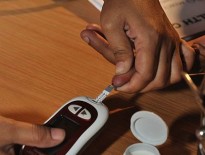
Credit: CDC Public Health Image Library #1832 / Cynthia Goldsmith
In 1976 a new virus entered the pantheon of lethal human pathogens – Ebola virus. That year outbreaks in Zaire and Sudan sickened 284 people and killed about half of them. Ebola virus causes an illness that initially resembles a typical intestinal virus, with fever, headache, joint and muscle aches, vomiting and diarrhea. Most patients quickly worsen and develop a rash, easy bleeding, and liver and kidney failure. About two thirds of the people who are infected die. Ebola is transmitted from person to person through infected bodily fluids, but since patients are frequently vomiting and suffering from diarrhea, and since outbreaks happen frequently in places with poor sanitation, infection can spread quickly. Without medical protective equipment, like gloves and masks, healthcare workers are often infected. The incubation period is two to four weeks. Ebola is also carried by wild animals, and bats are thought to be a reservoir of the disease.
Because Ebola is so rapidly fatal, previous outbreaks have been geographically very limited. It may infect everyone in a small remote village, but at least until now, infected people have been too ill to get on a plane or take a long car ride. The worst outbreaks have killed almost 300 people. New outbreaks have recurred in Central Africa every few years, presumably from contact with infected animals.
So far there is no vaccine or specific treatment for Ebola. It cannot be spread by respiratory particles (i.e. by coughing or sneezing). If it could, it would make the perfect bioterrorism weapon. The Centers of Disease Control and Prevention lists it as a Category A bioterrorism agent.
About ten days ago an Ebola outbreak was discovered in southeastern Guinea. This in itself is worrisome as it is the first Ebola outbreak in Guinea and in West Africa. But more worrisome is that this outbreak has spread geographically more than any other. Cases have been reported in Conakry, the capital of Guinea, a city of a million and a half people. Conakry is over 400 miles away from the region of the initial cases. And cases are also suspected in Liberia and Sierra Leone. In all (as of April 1) there have been over 130 confirmed and suspected cases and 88 deaths. 14 of the infected people are healthcare workers.
International health officials are scrambling to deliver isolation equipment to hospitals and are trying to educate the public to avoid touching people who become sick. They are also identifying and trying to isolate people who were in contact with patients. The media reports (links below) suggest the mood in Conakry is understandably tense.
Time will tell how much farther this outbreak will reach and how many lives it will claim. We hope that as resources are rushed to where they are needed human-to-human transmission will be interrupted soon.
But we are reminded that in less than 40 years after making the jump from other animals to humans Ebola virus has found its way to an African capital city. How many more years will it be until someone, unaware that he is infected and still in the incubation period, boards a plane and becomes violently ill while browsing paintings at the Louvre, or riding a double-decker bus in London, or seeing a Broadway play? Will our health systems be prepared to manage the ensuing chaos?
Learn more:
Q&A: Challenges of Containing Ebola’s Spread in West Africa (National Geographic)
Ebola outbreak spreads panic in West Africa (USA Today)
Why West Africa’s Ebola Outbreak Is So Scary (Slate)
6 Things to Know About the Latest Ebola Outbreak (Time)
Outbreak of Ebola in Guinea and Liberia (Centers for Disease Control and Prevention)

